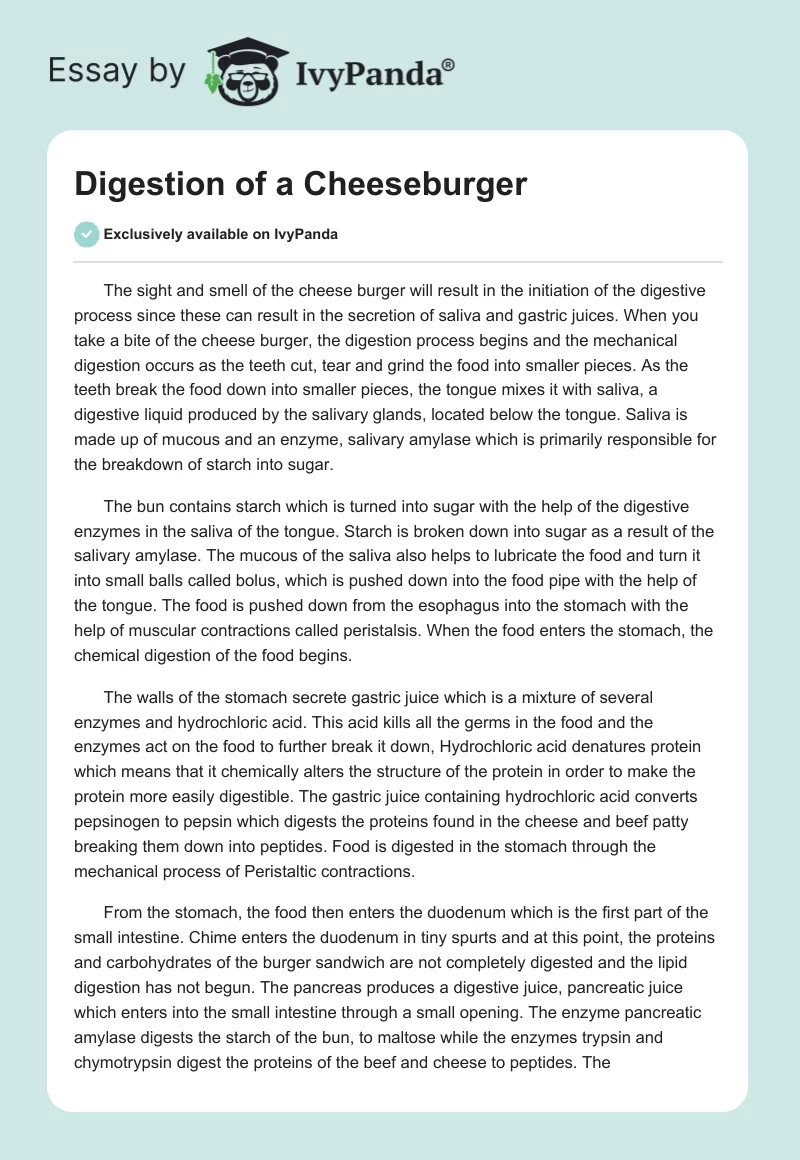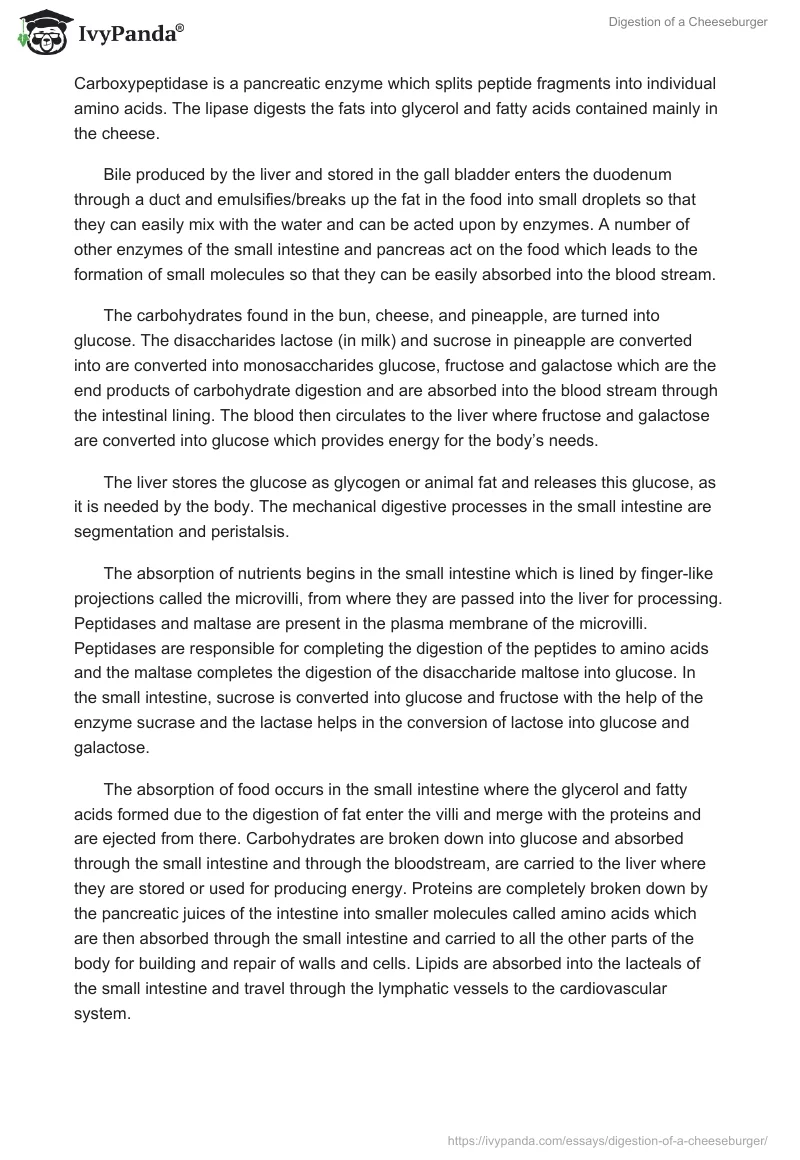The sight and smell of the cheese burger will result in the initiation of the digestive process since these can result in the secretion of saliva and gastric juices. When you take a bite of the cheese burger, the digestion process begins and the mechanical digestion occurs as the teeth cut, tear and grind the food into smaller pieces. As the teeth break the food down into smaller pieces, the tongue mixes it with saliva, a digestive liquid produced by the salivary glands, located below the tongue. Saliva is made up of mucous and an enzyme, salivary amylase which is primarily responsible for the breakdown of starch into sugar.
The bun contains starch which is turned into sugar with the help of the digestive enzymes in the saliva of the tongue. Starch is broken down into sugar as a result of the salivary amylase. The mucous of the saliva also helps to lubricate the food and turn it into small balls called bolus, which is pushed down into the food pipe with the help of the tongue. The food is pushed down from the esophagus into the stomach with the help of muscular contractions called peristalsis. When the food enters the stomach, the chemical digestion of the food begins.
The walls of the stomach secrete gastric juice which is a mixture of several enzymes and hydrochloric acid. This acid kills all the germs in the food and the enzymes act on the food to further break it down, Hydrochloric acid denatures protein which means that it chemically alters the structure of the protein in order to make the protein more easily digestible. The gastric juice containing hydrochloric acid converts pepsinogen to pepsin which digests the proteins found in the cheese and beef patty breaking them down into peptides. Food is digested in the stomach through the mechanical process of Peristaltic contractions.
From the stomach, the food then enters the duodenum which is the first part of the small intestine. Chime enters the duodenum in tiny spurts and at this point, the proteins and carbohydrates of the burger sandwich are not completely digested and the lipid digestion has not begun. The pancreas produces a digestive juice, pancreatic juice which enters into the small intestine through a small opening. The enzyme pancreatic amylase digests the starch of the bun, to maltose while the enzymes trypsin and chymotrypsin digest the proteins of the beef and cheese to peptides. The Carboxypeptidase is a pancreatic enzyme which splits peptide fragments into individual amino acids. The lipase digests the fats into glycerol and fatty acids contained mainly in the cheese.
Bile produced by the liver and stored in the gall bladder enters the duodenum through a duct and emulsifies/breaks up the fat in the food into small droplets so that they can easily mix with the water and can be acted upon by enzymes. A number of other enzymes of the small intestine and pancreas act on the food which leads to the formation of small molecules so that they can be easily absorbed into the blood stream.
The carbohydrates found in the bun, cheese, and pineapple, are turned into glucose. The disaccharides lactose (in milk) and sucrose in pineapple are converted into are converted into monosaccharides glucose, fructose and galactose which are the end products of carbohydrate digestion and are absorbed into the blood stream through the intestinal lining. The blood then circulates to the liver where fructose and galactose are converted into glucose which provides energy for the body’s needs.
The liver stores the glucose as glycogen or animal fat and releases this glucose, as it is needed by the body. The mechanical digestive processes in the small intestine are segmentation and peristalsis.
The absorption of nutrients begins in the small intestine which is lined by finger-like projections called the microvilli, from where they are passed into the liver for processing. Peptidases and maltase are present in the plasma membrane of the microvilli. Peptidases are responsible for completing the digestion of the peptides to amino acids and the maltase completes the digestion of the disaccharide maltose into glucose. In the small intestine, sucrose is converted into glucose and fructose with the help of the enzyme sucrase and the lactase helps in the conversion of lactose into glucose and galactose.
The absorption of food occurs in the small intestine where the glycerol and fatty acids formed due to the digestion of fat enter the villi and merge with the proteins and are ejected from there. Carbohydrates are broken down into glucose and absorbed through the small intestine and through the bloodstream, are carried to the liver where they are stored or used for producing energy. Proteins are completely broken down by the pancreatic juices of the intestine into smaller molecules called amino acids which are then absorbed through the small intestine and carried to all the other parts of the body for building and repair of walls and cells. Lipids are absorbed into the lacteals of the small intestine and travel through the lymphatic vessels to the cardiovascular system.
Then in the small intestine, several enzymes from the pancreatic juice and the lining of the intestine complete the breakdown of huge protein molecules into small molecules called amino acids. These small molecules can be absorbed through the small intestine into the blood and then be carried to all parts of the body to build the walls and other parts of cells.
The undigested part of the food in the form of sludge is then passed to the large intestine. It is in the large intestine that the water minerals and vitamins are absorbed and this is the place where the pineapple and the lettuce will be completely digested and the vitamins and minerals they contain are absorbed into the blood stream. The large intestine absorbs undigested nutrients such as sodium and excretes the waste matter through the rectum.
The primary functions of carbohydrates in the body are:
- To provide energy and regulate the glucose in the blood
- Spare the use of proteins
- Help in the breakdown of fatty acids
- To provide dietary fiber
Major functions of Proteins in the body:
- Growth and maintenance of cells, muscles, tissues and body cells
- Forming of blood cells and making antibodies which help in the protection of illnesses and infections.
- Substances which control body functions such as enzymes and hormones are made up of proteins.
Major functions of Lipids in the body:
- Storage of energy for future use
- Forming the membrane of body cells which gives it the essential function of permeability
References
Clinton Community College. Web.
Human Anatomy Online. Web.


